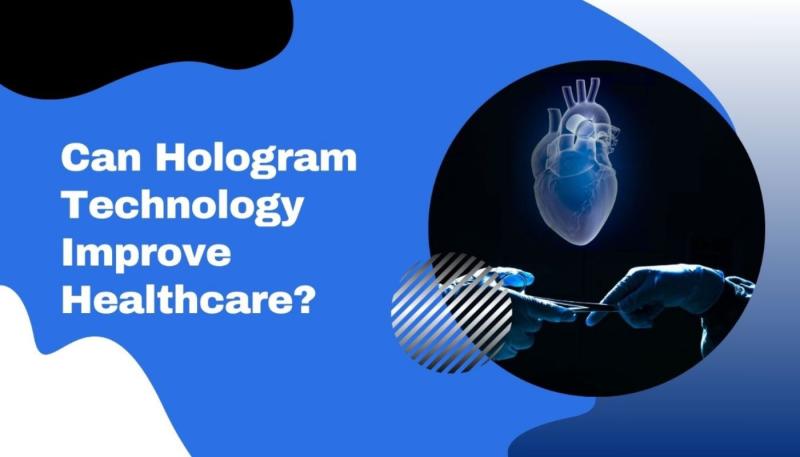Can Hologram Technology Improve Healthcare?

This hologram technology is disrupting many industries and will not exclude health. As a disruptive invention, holography provides a three-dimensional visualisation of complex medical data. Holography opens huge opportunities for improving medical professionals' diagnosis, treatment, and training. This article will provide how hologram technology can make a difference in healthcare by going through its applications, benefits, challenges, and prospects for the future.
Understanding 3D Hologram in Healthcare
Holography is a technique for recording and reconstructing light scattered from an object to reconstruct a 3D image viewed without special glasses. 3D Hologram company enabled health professionals to better visualize anatomical structures and medical conditions intuitively and interactively compared to traditional 2D imaging methods like X-rays and MRIs.
How Does Holographic Projection Work?
Surgical Planning and Guidance - Holograms can project a high-resolution 3D image of a patient’s anatomy, allowing for highly accurate surgical planning. The surgeon can identify with clarity the precise positioning of tumours or other irregularities. This will afford increased visualization that brings about the successful execution of intricate procedures. Real-time holographic guidance can be used during surgery to avoid critical structures, potentially reducing complications.
Medical Training - This is an immersive learning and training experience in the medical field for learners and professionals. Learners will be able to understand complicated physiological concepts and surgical techniques by studying anatomy through interaction with 3D holographic models of the human body. 3D Hologram in healthcare hands-on approach enhances spatial awareness and knowledge retention.
Remote Consultations - This holographic technology can bridge the gap that exists in healthcare accessibility in rural or underserved areas. Using holograms, doctors can make a virtual examination of patients through holo-telemedicine and evaluate from any other location while simultaneously giving the relevant information to local health providers for further treatment.
Patient Education - It can provide uncomplicated complex medicine information so that patients understand the disease process and treatment options better. The patient, by seeing a 3D hologram representing issues with his or her health, will understand and hence make informed decisions about his care, which will lead to better compliance and outcomes.
Tumour Localization and Treatment - Holograms can increase the accuracy of tumour localization, more so for deep-seated tumours. This would have very key implications for guiding radiation therapy and chemotherapy so that treatment only has minimal effects on cancerous cells, leaving surrounding healthy tissues intact.
What is a Hologram?
In contrast to this, a three-dimensional holographic image is a three-dimensional image made using the technique of holography: recording light fields' interference pattern due to an object by a coherent light source. This recording provides information not only about intensity but also about the light waves' phase, while the most successful models in popular science projects result in impressive depth and perspective. Properly lit, a hologram will naturally project a view of the original scene.
Holography gives the viewers a sense of observing from different angles, thereby creating a three-dimensional sensation that can be realized in no way other than with conventional photography. So, holograms find applications in security, storage of data, and artistic display, which makes holography versatile technology in modern imaging and presentation.
How Does Hologram Technology Become Vital?
There are many benefits of 3D hologram in health care.
Better Visualization - Holograms display all dimensions of organs and tissues in front of a doctor, thereby helping in better diagnosis and treatment.
Improved Accuracy - It allows the visualization of complex anatomical structures in 3D, associated with more accurate diagnoses and surgical interventions and, therefore, better patient outcomes.
Cost-Effectiveness - Though the potential first investment in holographic technology is high, it does promise to reduce misdiagnosis and complications related to surgeries.
Personalized Medicine - Holographic models are made on an individual patient basis, which would aid in the formulation of customized treatment plans with a view of the individual’s unique features of anatomy.
Challenges Facing Holographic Technology
Despite the million-dollar potential of hologram technology, there are several challenges facing full adoption into healthcare.
Cost - All holographic equipment and software are pretty expensive and hence may be unaffordable for most healthcare facilities, especially smaller clinics and rural hospitals.
Quality and Stability - Current holographic images may not always be photorealistic or stable, hence affecting their usability in a clinical setting. Quality improvement in holographic displays and continuous updating of technology are required.
Integration with Existing Systems - Any holographic technology that is implemented within healthcare needs to be very careful about the integration of the existing systems and workflows. This would also include addressing the data security concerns involved in protecting patient data displayed in holograms.
Training and Familiarization - Adequate training of healthcare professionals on how to make appropriate use of holographic technology should be conducted. It may involve extra time and resource expenses, which may be quite challenging in busy clinical environments.
Future Prospects
The future of hologram technology in health care looks bright. Scientists are already working towards developing holographic displays so that they are more lifelike and available. They are eventually going to add artificial intelligence to develop holograms in real-time from the standard techniques. Very high potential will come for holograms to be a standard tool in medical practice as technology evolves.
Conclusion
It will allow for far superior visualization that will increase the accuracy of diagnoses and treatments. Holograms will also make medical training considerably better. There are some challenges associated with hologram technology, but continual advancements appear to make holograms a standard medical tool shortly. Really, with the way holograms are being increasingly infused into healthcare, this might mean extremely improved health outcomes and experiences. To know more about holographic displays, get in touch with Vision3D customer care number - +91-8971953451.
Post Your Ad Here

Comments